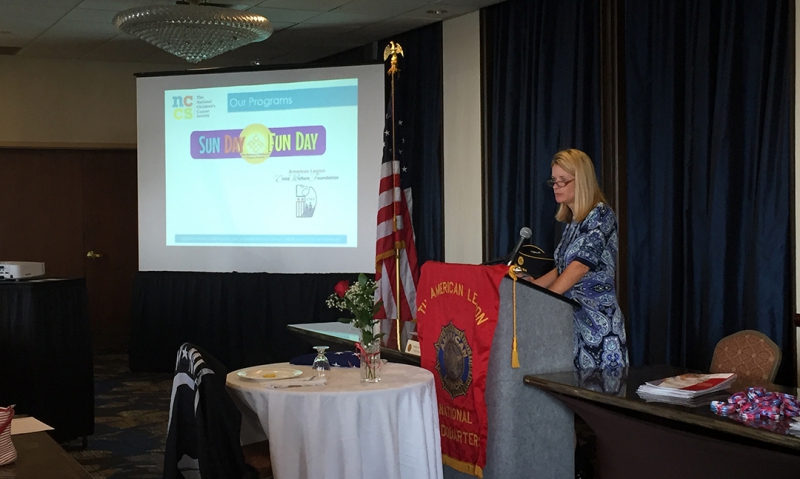
Legion donations help support childhood cancer survivors
After experiencing fatigue, dizziness and headaches, Riley Steiner thought she had mono. But blood test results left her “stunned and scared” – she was diagnosed with acute lymphoblastic leukemia in July 2014 at 17 years old.
The now 20-year-old sophomore at Miami University in Oxford, Ohio, is in remission and will complete her final round of chemo in October. Steiner, a National Children’s Cancer Society (NCCS) college scholarship recipient, shared her story of overcoming childhood cancer with attendees of The American Legion’s National Children & Youth Conference last Saturday.
Throughout her cancer journey, Steiner told Legion family members that she learned “that people who give their time and energy create something positive for kids who need their help. So thank you for everything that you do for children across the country,” she said. “I can’t wait to see all the ways kids are helped in the future by volunteers like you.”
Legion family members heard from Julie Komanetsky about the great work NCCS does to support families emotionally, financially and educationally as they go through childhood cancer.
NCCS is a four-time American Legion Child Welfare Foundation (CWF) grant recipient, with the first grant awarded 12 years ago.
“We have been very grateful to receive support from the Child Welfare Foundation throughout the years,” said Komanetsky, vice president of NCCS patient and family services. “Our relationship goes back to 2004, and you make us successful in what we’re doing for (childhood cancer) survivors and for children in general.”
The St. Louis-based nonprofit was founded in 1987 and since then has helped 38,000 children with cancer and their families across the United States, and has distributed more than $62 million to help those families.
Komanetsky shared statistics about childhood cancer, such as 16,000 children will be diagnosed with cancer each year, and it’s the leading cause of death by disease in children. A positive is that the survival rate for children with cancer is more than 80 percent; however, that comes at a price. About 66 percent of children who survive childhood cancer will suffer long-term challenges as a result of their invasive treatment.
“I think that kids who have survived cancer know what it’s like to go through something so traumatic and come out on the other side have an appreciation for life that many kids don’t have. So many of these kids want to go on and make life better for others,” Komanetsky said.
CWF grants have helped NCCS with survivorship materials, such as a video and book for parents and children on the long-term challenges that childhood cancer survivors often face. The grants also have helped create material on how to prepare survivors to be independent when attending college and dealing with medical issues, and the most recent grant helped NCCS launch its Sun Day-Fun Day program.
The program is intended to help children identify the key elements of sun safety, increase willingness to use sunscreen, and to encourage youth to fundraise to support children their age who have cancer.
“The goal is to impact kids at a young age, prepare them and encourage behaviors that hopefully they will use for a lifetime in order to see better results with skin cancer in adulthood,” Komanetsky said.
NCCS piloted the program two years ago by visiting seven schools which impacted 2,000 children. Since then, they have created a video of testimonials from youth who share what it feels like to get a bad sunburn – “Ouch!” – launched the hashtag #shadethatsun, and developed a toolkit that features a letter to parents to encourage sun safety at home, Sun Day-Fun Day posters to hang in schools, fundraising information, and more. The money youth raise for NCCS remains in their respective state.
The impact Steiner’s diagnosis had on her friends and community in Dublin, Ohio, is a testament to how people will financially support a great cause. Her friends had orange T-shirts and wristbands made with Steiner’s lacrosse jersey number (22) on them and the words “Steiner Strong” and sold them to students and community members to support leukemia research. The color orange represents leukemia awareness “and now it was my color as well,” Steiner said.
Steiner and her friends raised $12,000 from T-shirt and wristbands sales, and from other donations.
“I believed in the cause, I believed in our community, I believed that somehow my situation was going to turn out alright,” Steiner said. “They couldn’t fight for me, so they fought with me.”
The Sun Day-Fun Day program is intended for promotion in schools, but Komanetsky advised Legion family members that they too can host the program at their post or in their community. Learn more about the program here.
“The expansion of (the Sun Day-Fun Day) program is thanks to you and the Child Welfare Foundation,” Komanetsky said. “Thank you for everything you do for children across the country.”
View all presentations from the National Children & Youth Conference here.
